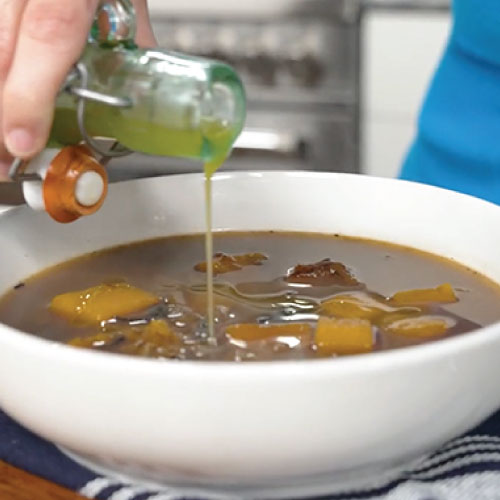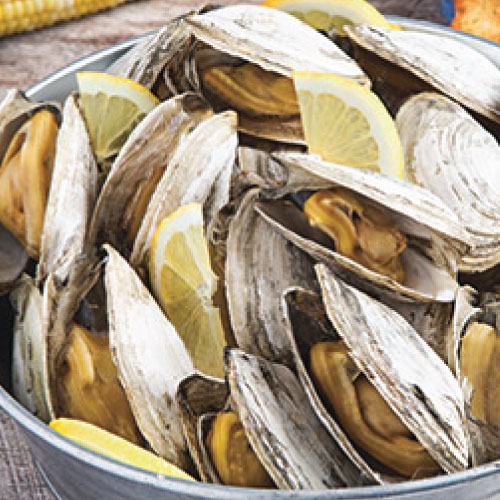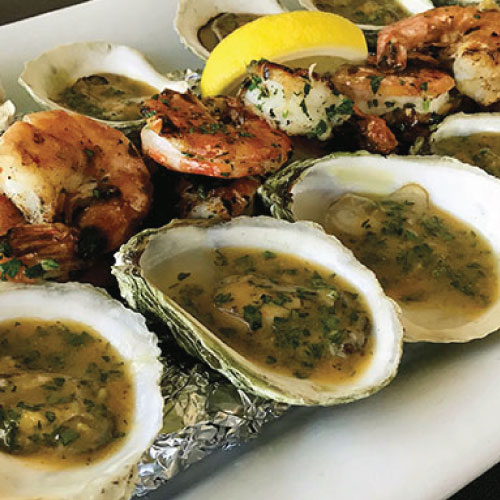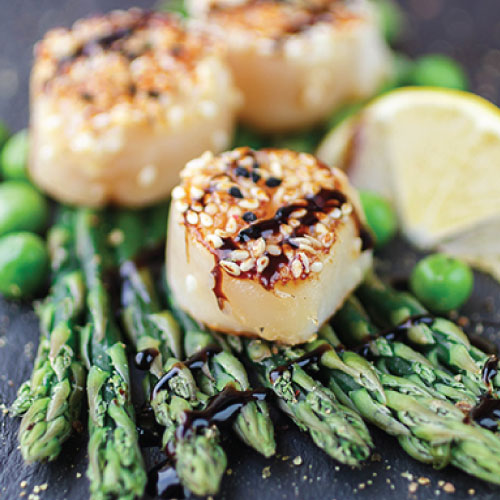
Cooking with Mollusks
Author: be well™ with Big Y® Registered Dietitian Team
Get cooking with mussels with these pointers from Big Y registered dietitian Carrie Taylor as she cooks up a delicious soup recipe from Barton Seaver.
Do you love ordering mussels, clams, oysters or scallops when dining out but shy away from cooking them at home? Not only is cooking with these mollusks easier than you think, they’re a great-tasting way to vary your protein intake, reach weekly seafood recommendations and add new recipes to your family’s favorite go-tos.
What are Mollusks?
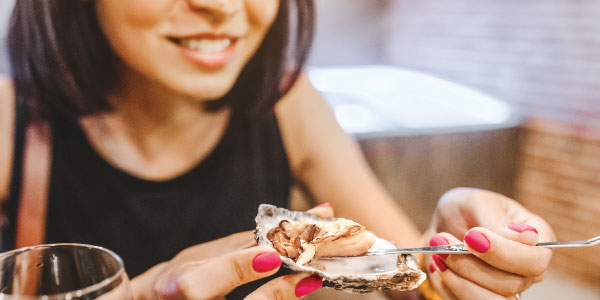
When you think of shellfish, mollusks are the group in which mussels, clams, oysters and scallops fall under. Additional members of the mollusk family are squid, octopus and snails. Biologically speaking, mollusks are invertebrates with soft bodies. Mussels, clams, oysters and scallops are considered bivalve mollusks with two shells divided in the middle creating right and left sides. As any steamer lover will attest to, the shells of bivalve mollusks, specifically the interior portion, can often look like works of art.
Nutrition Benefits of Mollusks
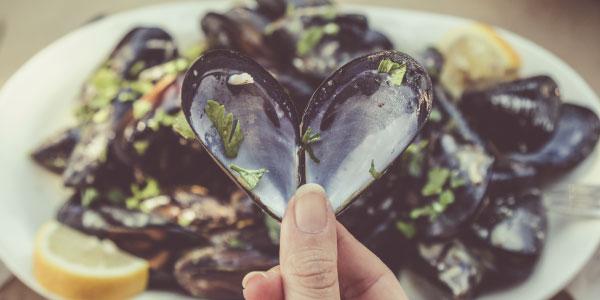
With delicious and distinct flavors among themselves (e.g.: Chatham oyster versus Wellfleet oyster) and between species (e.g.: cherrystone clams versus PEI mussels), the nutritional benefits of bivalve mollusks are worth noting too.
Protein is the primary nutrient offered by mollusks, with 0.85 gram per oyster and approximately 2 grams per clam, mussel and scallop.1 An array of additional nutrients present includes vitamin B12, zinc, selenium and choline. Though they are exceptionally low in fat, the primary fat these little protein-morsels provide are polyunsaturated omega-3 fatty acids.
Weekly Seafood Recommendations
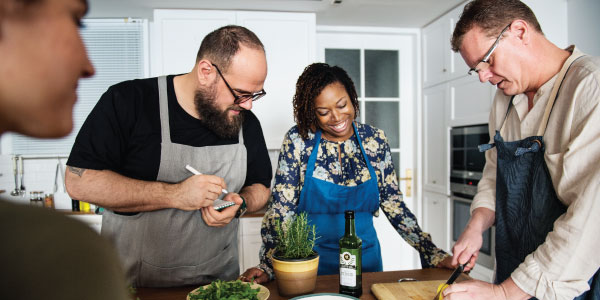
The United States Department of Agriculture (USDA) 2020-2025 Dietary Guidelines for Americans recommends eating 8 to 12 ounces of seafood weekly, with at least eight ounces coming from omega-3 sources such as salmon, sardines, tuna, oysters and mussels.2 Keeping in mind that mollusks aren’t necessarily the richest sources of omega-3 fats, these recommendations could equate to enjoying up to 4 to 6 ounces mussels, clams, oysters and scallops each week. Where “shell” you start? 😊
Cooking with Mollusks
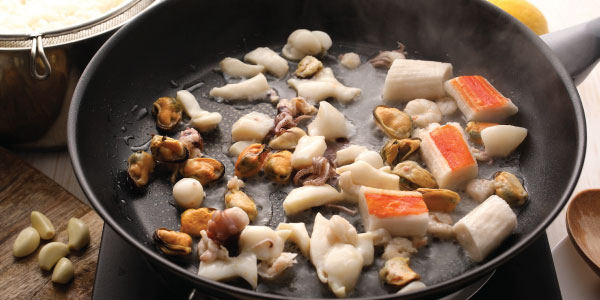
Let’s begin breaking down any barrier you may have to cooking with mollusks. They truly are a cinch to add into weekly meal prepping once you learn how to best handle them.
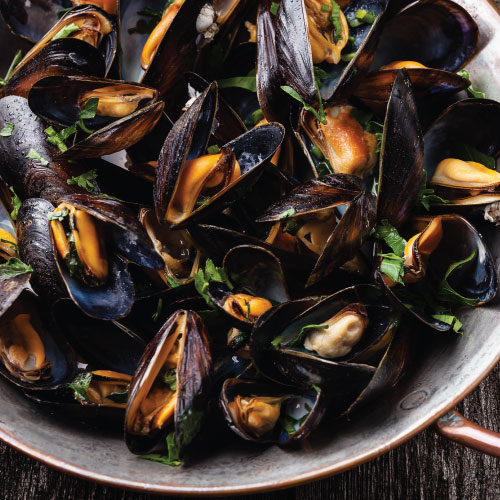
Cooking Mussels
Learn how to whip up mussels at home in delectable broth that becomes a craveable pairing to your favorite crusty bread and you may never order them out again. Begin adding them to soups and stews and your view of soup season may change.
The secret to cooking bivalve mollusks still in their shell? Understanding the majority of the work comes in the preparation. Once mussels, clams and oysters are checked for freshness and given a good rinsing prep, they cook up in minutes. The indicator? Their shells open.
Follow these steps to prep mussels before you begin cooking:
Step #1- Give fresh mussels breathing room. Once home after shopping, get them out of the plastic bag they are weighed and packaged in upon ordering in our Seafood Department. Place them on a plate in the refrigerator and be ready to prepare them that day or the next.
Step #2- Before rinsing, pick through to make sure only live mussels are chosen. Any with broken shells, open shells that do not close upon gently tapping on the countertop and a spoiled odor should be discarded.
Step #3- Scrub shells gently with your hands to remove any dirt and debris when rinsing. Pull off any brown thread-like seaweed poking out of shells (called the “beard”).
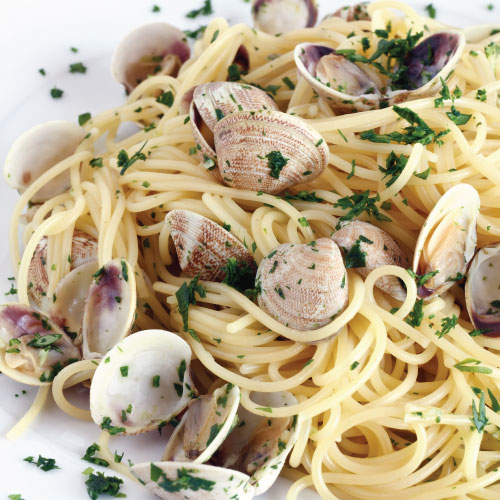
Cooking Clams
Steamed and dunked into a bath of clarified butter may be the go-to way New Englanders enjoy eating their clams but they also make delicious additions to soups, chowders, casseroles and bakes.
Follow these steps to prep clams before you begin cooking:
Step #1- Give clams air, just like their mussel counterparts. When you return home from scooping them up at your local Neighborhood Big Y Market, store them out of plastic and on a plate in the refrigerator. Since fresh clams are living, plan to cook them up that day or the next.
Step #2- Pick through clams and choose those with closed shells without breaks. To rinse, place in a bowl of water and scrub with a small brush to remove any sand present in the ridges of their shells.
If your recipe will include cooked clams, your prep work is done here. If enjoying raw clams in the half shell is what you’re after, follow these tips:
- Be prepared with tools. Grab yourself a sharp shucking knife, kitchen utility towel and bowl to collect juices.
- Fold your towel. The towel will protect your hand from getting cut, so fold it in a way where it will rest in the palm of your hand and allow you to still grip the clam.
- Cut steady. Holding the clam on the towel in your palm, slowly work the knife between the left and right shells. Once in, bring the blade around the edge to one corner and reverse direction to the other corner. This will sever the clam’s muscle attachments to the shells.
- Catch the goodness. When opening the clam, be sure to do so over a small bowl to collect the juice. It’s a flavorful addition to recipes.
- Unattach. Before removing the top of the shell, gently run the knife under the clam to unattach it from the bottom shell. Scrape off pieces of muscle that may still be stuck to the top shell. Then pull the top shell off.
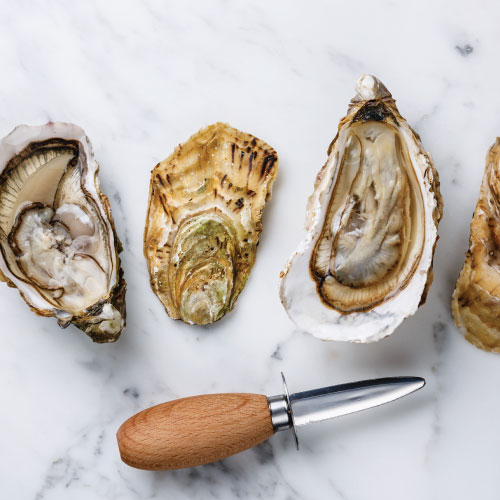
Cooking Oysters
You may enjoy oysters raw on the half shell, but these tasty morsels also taste delightful when cooked. Whether you’re adventuring with grilled oysters, baking them in the oven or breading and deep-frying canned oysters, there are plenty of delectable ways to enjoy them.
Just like their bivalve counterparts, take care to prep fresh oysters before cooking.
Step #1- Follow the same first steps above for mussels and clams for storing, selecting and rinsing fresh oysters.
Step #2- Since oysters are often prepared in the half shell, let’s discuss how to best shuck them so you maintain the integrity of their shell and don’t lose their coveted liquor (juice).
Shucking tools are the same as clams, but how you open an oyster’s shell is a bit different. For example, oysters have a hinge where the flat and curved sides meet. Learn more from our partner, Chef Andrew Wilkinson at North Coast Seafood, in this video.
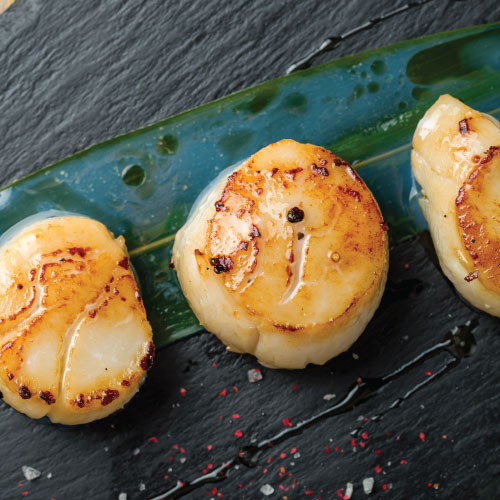
Cooking Scallops
With some of the most amazing, fan-shaped shells of the mollusk family, you more than likely will not find fresh scallops still intact in their shells. Rather, you’ll find the muscle of the scallop that attaches to both sides of the shell, called the meat, available. Since scallops can vary in size depending where they are caught—bay or sea—cooking time will vary. Regardless of how you like to prepare your scallops, cook them until they are firm and become milky white and opaque in color.
Tip when pan-searing large sea scallops? Don’t touch them!
Follow these tips for a perfectly seared scallop every time:
- Pat scallops dry with a paper towel.
- Wash hands. Season with salt and pepper.
- Preheat a sauté pan on medium-high heat.
- Once pan is hot enough that it sizzles when sprinkled with water, add plenty of oil to coat the bottom. Allow oil to heat up before adding scallops.
- Place scallops in pan with plenty of space in between each one.
- Without touching them, let scallops cook for about 3 to 3½ minutes on the first side. This will allow the naturally-occurring sugars present in scallops to caramelize. The scallops will release from the pan at this point, allowing them to be easily flipped to the other side.
- Cook on the second side for an additional 1 to 2 minutes or until they are firm and milky white, opaque in color.
Enjoy the deliciousness of mollusks with these recipes!
1 U.S. Department of Agriculture, Agricultural Research Service. FoodData Central, 2019. fdc.nal.usda.gov.
2 U.S. Department of Agriculture and U.S. Department of Health and Human Services. Dietary Guidelines for Americans, 2020-2025. 9th Edition. December 2020. Available at DietaryGuidelines.gov.
Published 8/3/2023



